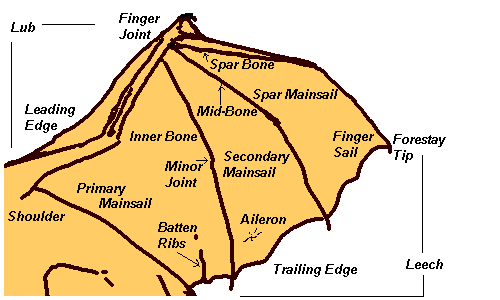Anatomy
Home > Weyrling Information > Weyrling Reference Room > Anatomy
The following sections can be read about dragon anatomy. If you have any questions, feel free to ask your Weyrlingmaster or any of the AWLMS.
THE HEAD
If you take a look at your life mate's head, you'll note that it's wedge-shaped with two little head knobs on either side. The head knobs have two purposes: 1) They help the hatchling break out of its egg. 2) They're used as sound receptors; dragons don't have ears as they're primarily telepathic.
Take a look at your lifemate's eyes. You'll see that they're protected by two protruding eyeridges and that they have three sets of eyelids called first lids, second lids and third lids. Eye colour tends to reflect a dragon's mood.
- Green/Blue -- Contentment
- Yellow/Orange -- Alarm/Worry
- Red/Deep Violet -- Anger/Sexual Arousal
- Grey/White -- Extreme Fear or Shock

THE NECK
Past the headknobs, you'll notice a series of ridges that trail down to his/her shoulders. A rider will sit between two of those neckridges when flying. The ridges will flatten out across the back and wing region until they reach the tail where they stick up again.

THE WINGS
Each of a dragon's wings are 3/4's the length of the body. So from wingtip to wingtip they are two-thirds longer than from tip to tail. A "dragonlength" is the tip to tail measurement. Their wings are bat-like with transluscent membranes that stretch over the three sections or "sails" of the wingframe. Their shoulders are heavily muscled where the wings attach to their bodies.
- Spar fingers - The long curved bones that form the main supporting structure of the wing.
- Leading Edge - The front edge of the wing. Note that it's doubled along the Finger Sail's leading edge to give more strength and control.
- Trailing Edge - The curving, batlike edge of the wing. Thick cartilage tissue strengthens this, making the edge look double thick.
- Primary Mainsail - The inner section of the wing from body to inner finger bone. It supports the bulk of the dragon's weight.
- Secondary Mainsail - The 2nd section of the wing between inner and middle-finger bones.
- Spar Mainsail - The smallest and outer section of the wing from middle to spar fingerbones. The Secondary and Spar are used for maneuverability.
- Finger Tip - The end of the Spar fingerbone at the very tip of the wing.
- Finger Sail - The area of spar mainsail adjacent to the finger tip. This area is fragile and can be prone to injury.

THE BODY
A dragon's body is very muscular, especially the haunches, which are used when launching into the air. The forearms are much smaller and end in five-digit claws called 'foreclaws'. The 'thumbs' on a dragon's foreclaws are opposable and can be used to grasp objects. When mounting a rider will use the forearm of his lifemate as a 'step-up'. Keep in mind that a full-grown dragon is quite large. A bronzerider, for instance, is shorter than his dragon's knee.

THE TAIL
The tail is where the dragon's excretory opening and genitalia are located. More precisely, the genitals are hidden within a protective pouch beneath the tail/body junction and are only revealed during a mating flight. The anal sphincter is at the fork in the tail.

